Honor Award
Brooklyn Botanic Garden Visitors Center
Brooklyn
HMWhite, New York City
Client: Brooklyn Botanic Garden
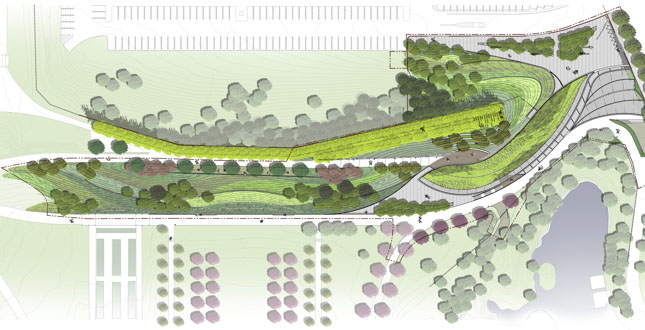 Close Me!
Close Me!Master Plan
A broader landscape context was examined beyond the Visitor Center's 3-acre project area to establish a landscape master plan that demonstrates appropriateness and technical environmental and landscape design resolutions within the Garden's larger historic landscape context.
Download Hi-Res ImageImage: Aaron Booher
Image 1 of 15
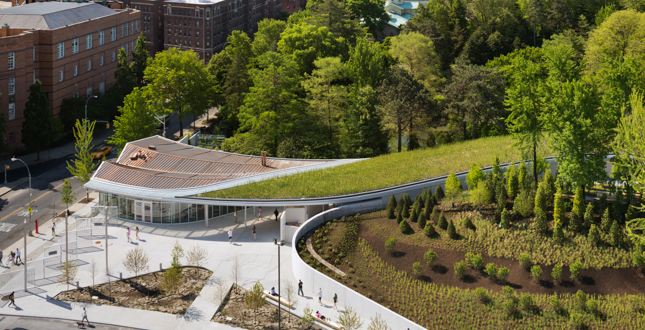 Close Me!
Close Me!Context
''Thanks to an extraordinary public-private partnership and an innovative design, this new Visitor Center will provide a welcoming place for people from across the street and around the globe to learn about sustainability and the Garden's remarkable collections.” MAYOR
Download Hi-Res ImageImage: Albert Mecerka/ESTO
Image 2 of 15
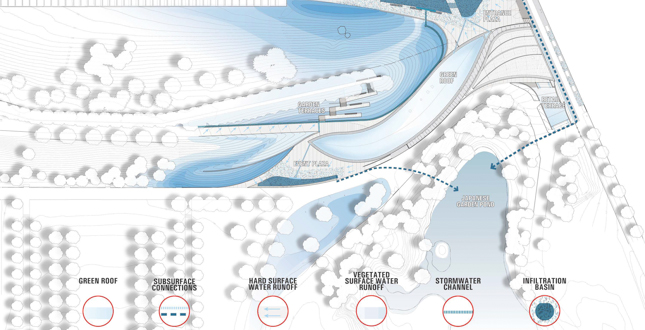 Close Me!
Close Me!Design Strategy
Sculpted water-collecting features direct, collect, filter and infiltrate stormwater runoff within the berm's woven composition of woodland, prairies and wet meadow native plantings The sculpted landscape is both artful and practical in absorbing and retaining stormwater onsite.
Download Hi-Res ImageImage: Aaron Booher
Image 3 of 15
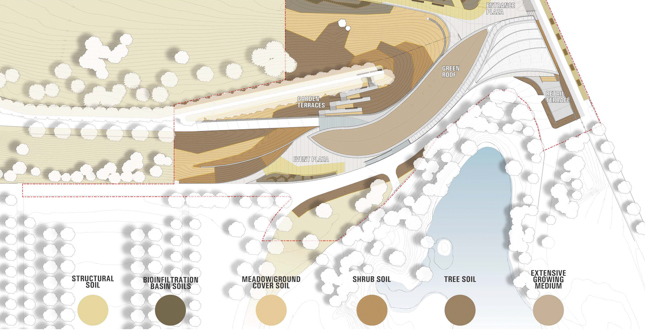 Close Me!
Close Me!Soil Technology
The selection of “water wise” plant typologies required soils and their profiles to be engineered to meet each plant community's performance criteria. Water absorption and drainage capacity designs were coordinated with existing subgrades and amended salvaged insitu soils.
Download Hi-Res ImageImage: Aaron Booher
Image 4 of 15
 Close Me!
Close Me!Living Roof
The leaf-shaped living roof supports over 40,000 plants, adding the Garden's first structured landscape to its collection. The 10,000 square-foot living roof captures approximately 190,000 gallons of stormwater per year in combination with the landscape design's stormwater channels.
Download Hi-Res ImageImage: Aaron Booher
Image 5 of 15
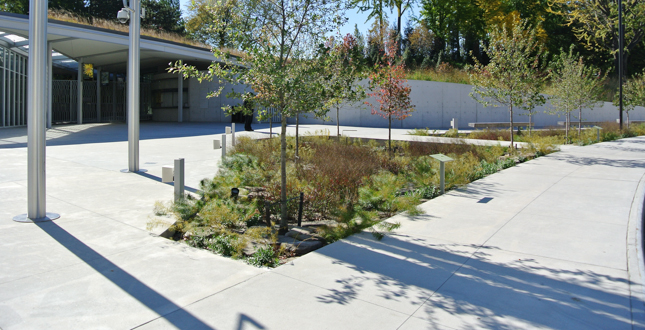 Close Me!
Close Me!Entrance Plaza Garden
This bioinfiltration basin emerges as a welcoming and educational garden at Washington Avenue's plaza. Stormwater is delivered via a diffuser and is spread over a distribution rill, dispersing water through the plantings and eliminating water detention facilities.
Download Hi-Res ImageImage: Albert Vecerka
Image 6 of 15
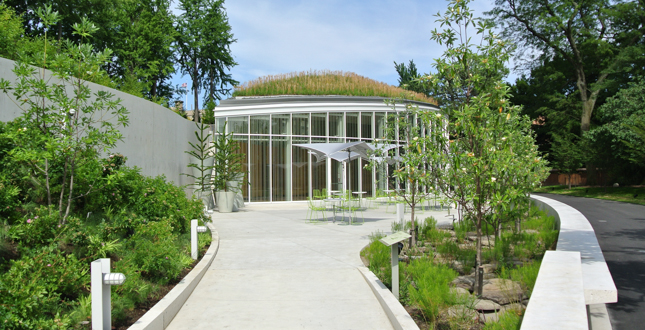 Close Me!
Close Me!Event Plaza
The landscape design manipulates both subtle and dramatic grade transitions to accentuate the hillside's topographic presence through pathway extensions and linkages, revealing a series of garden terraces and an event terrace with its featured rain garden.
Download Hi-Res ImageImage: Aaron Booher
Image 7 of 15
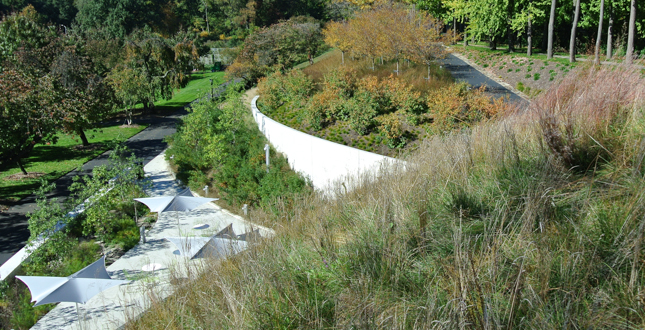 Close Me!
Close Me!Landscape / Building Infusion
The building's meadow roof emerges as an inhabitable extension of the hillside. The site design extends the Garden's pathways above, around and through the building, enabling new plant communities to weave within the existing landscape fabric.
Download Hi-Res ImageImage: Aaron Booher
Image 8 of 15
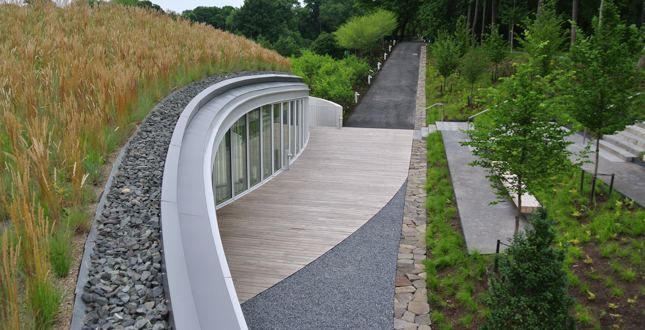 Close Me!
Close Me!Building/Landscape Transitions
“The landscape design's mastery is to be found in the way it manages to assert itself by providing a legible system of organization, while allowing for certain slippages to occur (most notably, between the urban and botanical).” Periodical
Download Hi-Res ImageImage: Aaron Booher
Image 9 of 15
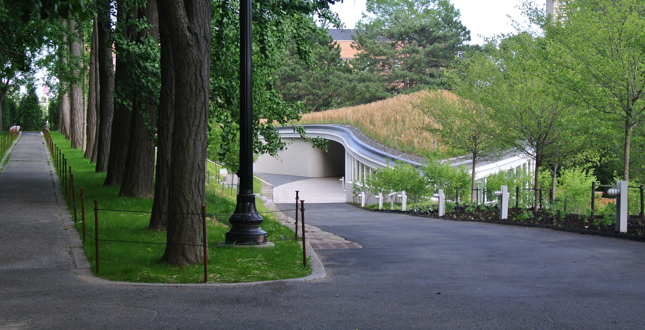 Close Me!
Close Me!New Meets Old
The berm's ridge hosts a mature Ginkgo tree allée and axial path, which serves as a grand balcony overlooking the Garden's collections. Formerly a woodland ramble, the exposed hillside emerges as a new garden canvas to showcase the woodland grassland.
Download Hi-Res ImageImage: Aaron Booher
Image 10 of 15
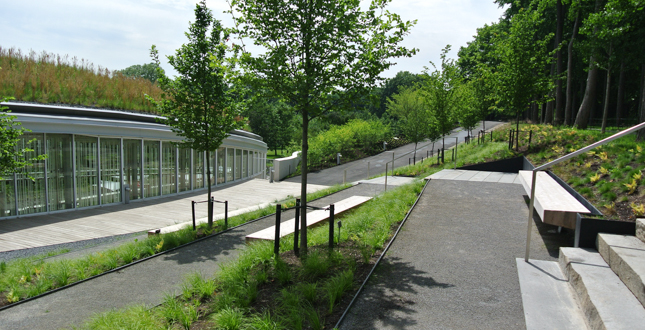 Close Me!
Close Me!Tiered Garden Terraces
Strengthening physical and visual connections to the Ginkgo Allée, three tiered terraces establish new viewing and social gathering opportunities-a useable slope transition, which introduces a new garden route that slips through the back of the building.
Download Hi-Res ImageImage: Aaron Booher
Image 11 of 15
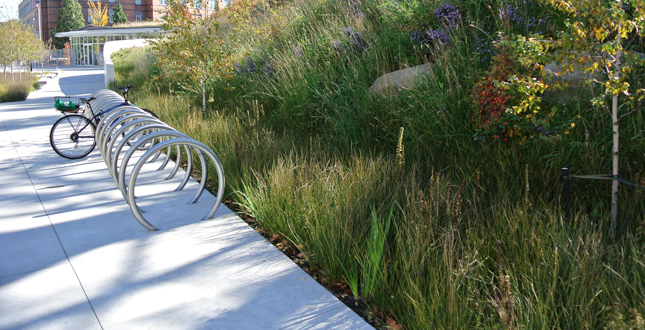 Close Me!
Close Me!Seasonal Diversity
"Though visually stunning in all four season, the diversity of plantings at the Visitor Center have a much deeper significance than immediately the eye: they help make this urban project a place to learn about ecological design..."
Download Hi-Res ImageImage: Aaron Booher
Image 12 of 15
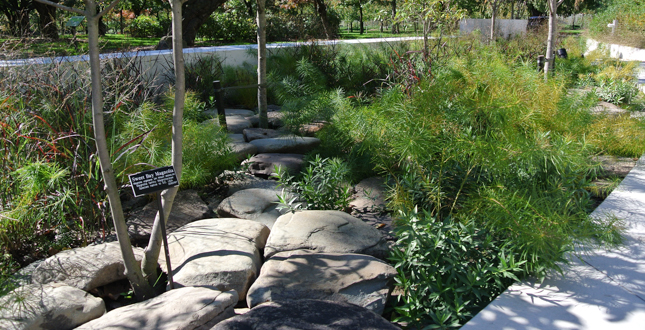 Close Me!
Close Me!Controlled Diversity
"The Visitor Center is a tremendous achievement in its marriage of plant ecology and architecture, from the 10,000SF living-roof, to the 60,000 plants that the garden visitor encounters in the planted areas elsewhere on the project site" Client
Download Hi-Res ImageImage: Aaron Booher
Image 13 of 15
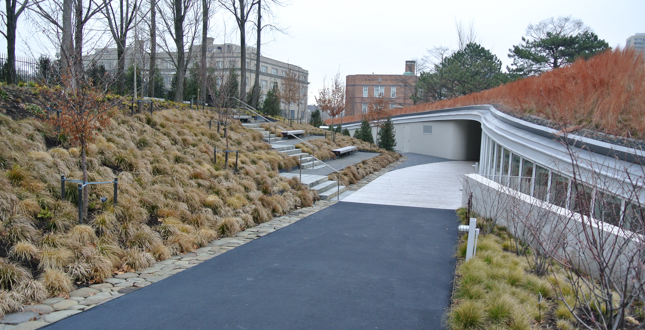 Close Me!
Close Me!Seasonal Character
The landscape design's seasonal evolution allows for distinct features and subtle qualities to be brought into higher focus. Varying seasonal lighchosen plant collection.
Download Hi-Res ImageImage: Aaron Booher
Image 14 of 15
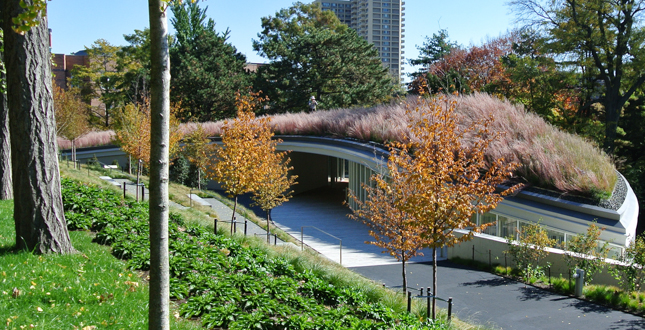 Close Me!
Close Me!Future Is Now
“If the next century will be all about man leaning to live with nature rather than fighting to conquer it, it is buildings like this that will show the way.” Periodical
Download Hi-Res ImageImage: Aaron Booher
Image 15 of 15
Project Statement
The Brooklyn Botanic Garden visitor center establishes a visionary public interface between city and garden. Fusing contemporary site engineering technology with sustainable landscape and horticultural design, the landscape design marks the Garden's centennial and demonstrates the institution's commitment to environmental stewardship and conservation. As a seamless, inhabitable extension of the Garden, the building's living roof design mergers landscape and architecture, redefining physical and philosophical relationships between visitor and garden, exhibition and movement, culture and cultivation.
Project Narrative
—2013 Professional Awards Jury
Project Purpose
Integrate the building design, living roof and 3 acre botanic garden landscape context of the Visitor Center as the Brooklyn Botanic Garden's new gateway. With the building's sinuous form as an extension of the Garden's hillside, the landscape design is fused with structure. The landscape design demonstrates BBG's commitment to environmental stewardship. The integration of the site's ecological engineering and horticultural design offers a new pedagogical paradigm with BBG's first high-performance botanical exhibit.
Site Context
The Visitor Center is sited on Washington Avenue at the Garden's northeastern corner where its street orientation and 385 linear feet of winding movement into the Garden provide a sequential transitional threshold between city and nature. A 25-foot high berm functions as the Center's verdant backdrop and topographic anchor. The preservation of the berm's mature Gingko allée and axial path serve as a historic organizing landscape feature against which the building's walls and landscape's flowing plant massings are registered. The Garden's original paths are woven through the building's two levels, enabling garden views to be framed and experienced as a series of episodic events.
Role of the Entrant
Working in close collaboration with the building architect and civil engineer, the landscape architectural team integrated a biologically based stormwater management strategy as the basis for the project's resilient site and landscape design. The landscape architect led a holistic site engineering approach that established a sculpted landscape comprised of a series of landscape systems - living roof, bio-swales, bioinfiltration basins and featured rain gardens. The landscape architect engaged a soil scientist consultant to engineer and coordinate soil profiles with each landscape system for supreme performance. Integration of architectural retaining walls, tiered garden terraces and rain garden architectural components were designed and documented by the landscape architect. More than 100 project plant species were researched, specified, sourced and designed for each of the project's landscape systems and horticultural features.
Special Factors
Site Design
The relationship between the berm and the pond summarizes the 3-acre site design for the new Visitor Center: the convex and the concave; the movement and collection of water. This yin/yang approach further informs the development of a unique and sustainable architectural gateway integrated into its landscape context. The project's LEED Gold certification was achieved through the system of stormwater management components that incorporates an extensive green roof, stormwater channels, riparian plantings within bio-infiltration swales and basins and ultimately terminal rain gardens. Collectively, these features eliminate need for costly subsurface water detention facilities and establish a self-sustaining landscape design as a network of new “high-performance” landscape typologies that provide unique pedagogical exhibits for the Garden.
Stormwater Management
A comprehensive network of stormwater management elements defines a critical component of the site design. An extensive green roof, stormwater channels and planted depressions gather runoff from the berm as ephemeral water features, and mitigate its flow to bio-infiltration basins which retain on-site stormwater and encourage infiltration and ground water recharge.
Soil Reclamation
Contaminated soils in the hillside's historic fill demanded remedial action. While some contaminated soils were capped, specific soil profiles were designed to restore viable soil biology to support each diverse horticultural condition. Designed to absorb and filter pollutants, the soils of the bio-infiltration basins have improved the site's water quality. Structural soils were placed under sidewalks and within plaza paving to support adjacent rain gardens and expand volumes of stormwater capture and root growth. Distinctly engineered soil profiles were designed for each planting condition, ranging from upland planting and horticultural subsoils to lowland bio-infiltration and structural soils.
Salvaged Materials
Architectural design and topographic modifications required that some of the existing Ginkgo trees be removed. The oldest (over 100 years) and largest Gingko tree was successfully transplanted on-site, while others were harvested, milled and integrated into building interior finishes. Likewise, salvaged native black locust lumber is utilized for wooden decking and timber slab bench seating at the garden terraces and entrance plaza.
Living Roof
The landscape's central feature is the building's 10,000 SF living roof design, conceived as a seamless, inhabitable extension of the Garden. Merging landscape and architecture, the living roof redefines physical and philosophical relationships between visitor and garden, exhibition and movement, culture and cultivation. A custom garden roof assembly supporting a blend of more than 40,000 plants was developed to maximize growing medium depth within the roof's load limitations.
Horticultural Exhibit
Informed by native plant communities, the planting palette distinguishes a gradation of typologies, from upland to lowland, to establish an armature for unique high-performance botanical collections highlighting trees, shrubs and meadows that withstand and thrive through periods of drought and inundation. Collectively, the planting design establishes an iconic botanic exhibit that demonstrates the distinct role plants have in how a landscape functions and performs. This horticultural design introduced 90 new plant species and varieties to the Garden's collection. Its expansive displayed and distinct weaving and weft composition establish a new pedagogical tool that showcases native plant communities as a vital ecological system component as well as highlighting their inherent beauty and vast seasonal characteristics.
Project Resources
Lead Designers
Hank White, FASLA – Principal-In-Charge
Aaron Booher – Senior Landscape Architect/Project Manager
Landscape Architect of Record
HMWhite
Architect and Site Design
Weiss/Manfredi
Civil and Structural Engineers
Weidlinger Associates
MEP and IT
Jaros, Baum & Bolles Consulting Engineers
Lighting
Brandston Partnership
Sustainability
Viridian Energy and Environmental
AV/Acoustic/Security
Cerami & Associates
Cost Estimator
AMIS Inc.
Geothermal/Geotechnical
Langan Engineering & Environmental
Interactive Displays and Signage
Thinc Design
HM White Sub-Consultants
Soil Scientist
Pine & Swallow
Green Roof System
Roofmeadow
Arborist and Soil Foodweb Specialist
Ecological Landscape Management
Contractors
Construction Manager
LiRO
General Contractor
EWHowell
Landscape Contractor
Kelco
Green Roof Contractor
New York Green Roofs
Featured Products
Plants
Bigelow Nursery
County Line Nurseries
Halka Nursery
Moon Nursery
Mahoney Farms
Outback Nursery
Penn State Seed Company
Perennial Farm
Pinelands Nursery
Rivendell Nursery
Schichtel's Nursery
Sunny Border Nursery
Sunshine Farm & Gardens
Sylva Native Nursery
Thievon Horticultural
Tuckahoe Nursery
Waynesboro Nursery
Soils
The Dint Company
Furniture
Landscape Forms
Lumber/Decking
Black Locust from CitiLog
Green Roofs
Roofmeadow
Stone
Connecticut Stone




